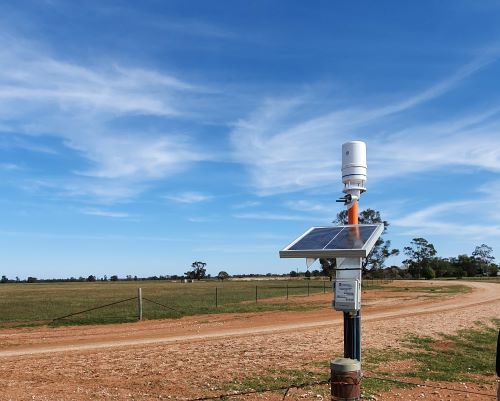Sensors on Water Trough

Sensor on Pump

Sensor on Gain Silo

The AWS provides data that can help a wind chill index through local wind, temperature and rain measurements. An understanding of these measurements allows sheep and cattle producers to manage cold stress through the provision of shelter or adjusting fibre content in feed.
It's worth noting that the producer observed a difference in how often data was transferred from different rain gauges to his devices. A rain gauge from a different AgTech provider only uploaded the total rainfall amount 4 – 6 times a day, whereas the AWS in this study reported conditions every 15 minutes. This increased regular data transfer meant that the producer could make more immediate decisions.
The team was able to set up alerts when tank and trough levels dropped below a certain height. This provided the producer with peace of mind and saved time as they no longer needed to regularly drive around to check tank and trough levels and were notified if there was a problem. However, it's worth noting that livestock were able to pull the sensor out of the trough so inaccurate data or false alerts could be detected.
Throughout this project, adaptations were made to the sensors to combat unforeseen circumstances. For example, the solar panel on the soil moisture sensors had to be raised as the canola planted in the paddock grew to be higher than the initial install height. Another example is the structural integrity of the antennas attached to the sensors which had to be modified to make them less susceptible to bird damage. When installing soil moisture sensors in paddocks that are to be tilled, ensure that the depth of the buried cables are adequate depth to prevent damage during ploughing. If the cables were laid deeper in the soil, then the producer would lose less cropping area and be able to drive machinery more efficiently.
Outcomes from the pilot
Overall, the project found that local data can lead to improved animal welfare because patterns of risk can be built, and management activities modified to suit conditions. Monitoring soil temperature and moisture helps inform pasture prediction modelling, providing an estimate of pasture feed on offer. The manager at Centre Plus uses the data from the soil moisture sensors to plan what crops to plant.
The producer at Centre Plus Merino saw the benefits of the data from the digital sensors and continues to use the sensors to guide decisions.
One of the previous participants that took part in the trial in 2019 saw the benefit in using sensors and invested over $40k in 2020 to expand the trial network.
The initial plan was to expand this producer network through field days, however the COVID pandemic forced the project to change direction through the adoption of larger demonstration farms.
References
NSW Department of Primary Industries (2023), Performance, Data, and Insights: Executive Summary accessed April 30, 2024.
Meat and Livestock Australia (MLA) (2023), State of the Industry Report 2022 accessed April 30, 2024
Livestock Pilot Poster
(PDF, 6178.67 KB)

Hear how livestock farmers are adapting to climate change
Luke Winder
Pigs, Poultry, Beef, and Lambs

Bruce Maynard
Mixed grazing and cropping

Stacey Lugsdin
Self-replacing Merinos

Matthew Martin
Merino Stud and Beef Cattle

Peter and Darcy Skipworth
Beef, Sheep, and dryland cropping

Martin Royds
Beef cattle and pasture chickens

Climate-Smart Farmer Stories
Hear from farmers who are adapting to the changing climate.This work was part of the Primary Industries Climate Change Research Strategy and was funded by the NSW Government’s Climate Change Fund.
 With a gross value of $7.9 billion in 2021-22, the NSW livestock industry contributes almost a quarter of the value of Australia’s livestock production. However, like other agricultural enterprises, it faces challenges from a changing climate and extreme weather events.
With a gross value of $7.9 billion in 2021-22, the NSW livestock industry contributes almost a quarter of the value of Australia’s livestock production. However, like other agricultural enterprises, it faces challenges from a changing climate and extreme weather events.

